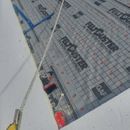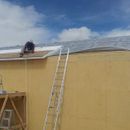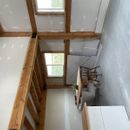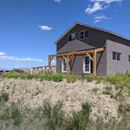Unvented roof creaks as sun heats it up in morning
I’m wondering if there is any way to fix this without pulling the shingles or sheeting.
I built a post and beam house wrapped in 4in EPS foam. The roof is a hot roof sandwich panel of 7/16 OSB with 4 inch of EPS in the middle. There is no adhesive and I think this is my mistake. We used 6in glavanized screws and hit the rafters underneath. There is spray foam inbetween every sheet of foam and they are pushed tight together. The walls are EIFS stucco and do not make any noises as they heat up.
The stackup from top to bottom:
-architectural asphalt shingles
-synthetic underlayment
-7/16 OSB (spaced 1/8 inch apart from eachother, screwed through to rafters with 6in galv screws)
-4 in EPS foam (held inplace with just a screw or two as the osb was immediately laid ontop next)
-synthetic underlayment (the framing was completed in december and had a few major snows that held off finishing the roof for two months. This was temporary but left inside the assembly)
-7/16 OSB (nailed with 8d nails to the rafters)
The noise is fairly loud and makes a sequence of creaks every few minutes for about two hours in the morning. It also makes a few less lengthy creaks as the sun sets. I believe the noise comes from inbetween the top sheet of OSB and the foam?
I know I only have 4in of foam all around the house and that does not meet code for the ceiling. I have thought about filling the rafter bays with cellulose too. But also, January’s heating bill was only $90. The only heat source is electric radiant wires that heat the slab. The house has big south facing windows and very limited surface area for the square footage (1500sqft). Adding cellulose insulation in the rafter bays may dampen the noise? But also, reading the article on cathedral ceilings, I know that I cannot have 8in of cellulose under 4in of EPS foam. That will put the condensation point inside the cellulose.
The shingle assembly was abruptly planned. I had been intending to put a metal roof on top of diagonal purlins above the foam but the HOA denied that after the roof was halfway built and I rushed to order shingles instead. I wish I did more research. I’m hoping I can reduce the noise somehow. The roof is only a year old now. I’d rather do a major fix to it when the shingles start to go and I can then put a metal roof on when there is new hoa leadership.
GBA Detail Library
A collection of one thousand construction details organized by climate and house part













Replies
You could try painting the shingles with a lighter color. It won't last for long, but should help with the noise.
Insulation on the inside won't do much for the sound since it is in the structure. Plus if your heating bills are low, there is no financial return for more.
Unless you are are careful, metal roofs will also have some thermal expansion noise, so it is not a fix all.
Jim,
Were sheathing clips used at panel joints above the foam, like PSCL/PSCA or H-clips or other spacers? Do any areas of the shingles looked buckled at sheathing joints? As you noted the issue is likely above the foam where thermal expansion/contraction stresses would be most extreme. It could also be those stresses being transferred down to the rafters. Hard to pinpoint, but I do know wood-to-foam wouldn't creak. It's wood-to-wood.
Adding some acoustical panels at the ceiling could help muffle some of the sound, but this is a band-aid. The real fix is likely pulling the shingles to investigate, cutting joints to accommodate movement, and/or adding furring for a ventilation gap that will support a metal roof to cool things off.
Best,
j
Jason,
No I did not use any clips. I put a couple 8d nails inbetween the panels until they were screwed into place. Thank for that info. I need to read up on them. I could possibly add those by only lifting up some shingles.
I have not noticed any buckled shingles. I will get up on the hill and sight down the roof plane tomorrow morning and at full sun.
How certain are you that the noise would not come from between the foam and wood?
Also, be careful on those overhangs; foam is not structural!
At least not in tension.
Yipes! Good spot.
In Montana it is incredibly common for us to frame the gable overhang by just running the OSB long up to a foot (this is only 8in). And then screw the subfascia to that overhang. The guy I frame for usually has us build a ladder onto the gable truss. But, I see this all the time. So for the gable at least I have no concern. I didn't need to run the foam long as well, but did it to fill the space(plan to finish the underside somehow).
The eave is different as usually the truss has tails down. But so far I have not seen any sag. It is only an 8in overhang. I have considered adding ornate timber rafter tail supports at some point if it is a problem.
I took a quick look at the thermal expansion of materials in your roof.
Assuming the roof heats up by 100F (probably less but near that).
Plywood has a CTE 0.04" per 10' of length, which falls into the squat category.
EPS on the other hand is 0.42", which is a fair bit.
Most likely the noise is the foam sliding against the top plywood surface, which there is no easy fix for without taking off the roof.
If you are re-roofing, the best solution is to add another layer of thinner foam on top before the metal roofing goes on. This should reduce the temperature swing of the assembly and keep the popping at bay. Much less work than taking the plywood off to glue it down.
Having lived with metal roof, I've gotten used to the occasional pop. The best solution is to get used to it. It could also be that once the assembly goes through enough heat cycles, some of the noise could go away as things wear in.
Thank you Akos for looking that up. Interesting that its the foam moving.
I am pretty used to the noise and its not really a big deal. I just definitely want to talk about it and not let it happen again. I wonder if other hot roofs have this problem or how they address it.
Yes, great idea. Hopefully can add something thin before reroofing with metal in a decade. Take the OSB all the way off would be a really big project. Although I could just lift up one sheet at a time and glue and set it back in maybe.